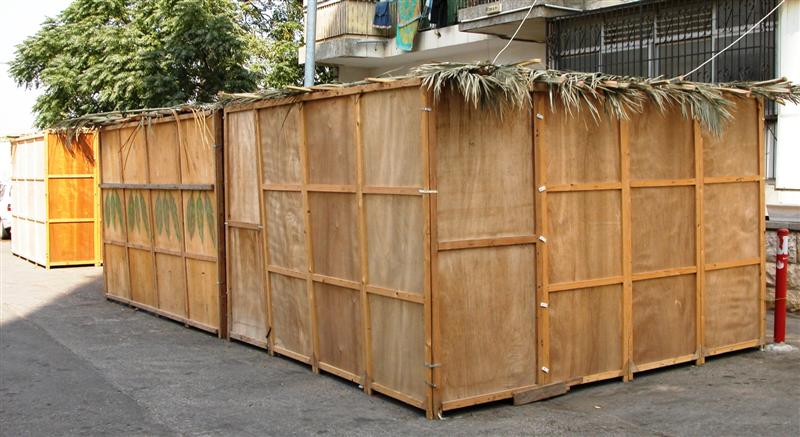
Sukkot, the Harvest Festival, occurs on 15 Tishri (in September or October). The word Sukkot means booths, and refers to the temporary dwellings (sukkah) that we are commanded to live in during this holiday. Sukkot is also a harvest festival, and is sometimes referred to as Chag Ha-Asif, the Festival of Ingathering. The festival of Sukkot is instituted in Leviticus 23:34. It is the third of the three pilgrimage festivals with both historical and agricultural significance (the other two are Pesach and Shavuot). No work is permitted on the first and second days of the holiday.
Sukkot is a time of joy and celebration. It is the final celebration and thanksgiving for the year’s harvest. During the times of the Tabernacle and Temple offerings were brought on each day of Sukkot. Zechariah prophesied a time when all the Nations will join Yisrael in Sukkot and worship the Eternal One (Zechariah 14:16-19).
The holiday commemorates the forty-year period during which the children of Israel were wandering in the desert, living in temporary shelters. The commandment to “dwell” in a sukkah can be fulfilled by simply eating all of one’s meals there; however, if the weather, climate, and one’s health permit, one should live in the sukkah as much as possible, including sleeping in it. It is common practice, and highly commendable, to decorate the sukkah. In the northeastern United States, Jews commonly hang dried squash and corn in the sukkah to decorate it, because these vegetables are readily available at that time for the American holidays of Halloween and Thanksgiving.
Rabbinic Traditions
Another observance related to Sukkot involves what are known as The Four Species (arba minim) or the lulav and etrog. We are commanded to take these four plants and use them to rejoice before the L-rd. With these four species in hand, one recites a blessing and waves the species in all six directions (east, south, west, north, up and down, symbolizing the fact that G-d is everywhere). The four species are also held during the Hallel prayer in religious services, and are held during processions around the bimah each day during the holiday. These processions, known as Hoshanahs, commemorate similar processions around the alter of the ancient Temple in Jerusalem.
Karaite Traditions
B’nei Yisrael is commanded to live in the sukkah – eating, drinking, reading, and praying there – throughout the chag. According to Karaite tradition, the sukkah must be large enough to accommodate everyone who wishes to enter it. The sukkah must be open to the sky and have a roof covered entirely in branches. It is also customary to decorate the sukkah with colorful cloth and fresh fruit.1
——————–
1al-Qirqisani Center. An Introduction to Karaite Judaism: History, Theology, Practice, and Custom. Troy, NY: al-Qirqisani Center for the Promotion of Karaite Studies, 2003.
Shemini Atzeret – known in English as the Eighth Day of Assembly – occurs on 22 Tishri (in September or October). Shemini Atzeret is a day of assembly that immediately follows Sukkot on the twenty-second day of the seventh month.
…on the eighth day, a proclamation of holiness shall there be for you, you are to bring near a fire-offering to יהוה – it is (a day of) Restraint – any kind of servile work you are not to do. (Leviticus 23:36)1
It brings the celebration of Sukkot into a state of perfection and is celebrated by prayer and the ending of the stay in the sukkah. Shemini Atzeret literally means the assembly of the eighth (day). No work is permitted on Shemini Atzeret. (In Israel Shemini Atzeret and Simchat Torah are celebrated on the same day).
Shemini Atzeret is a time of gathering for the Children of Israel as noted in First Kings 8:66 and Second Chronicles 7:10. It is on this day that the annual reading of the Torah is completed and a new Torah-reading cycle begins.
Karaite Traditions
This is also a day of celebration in the Karaite Beit Knesset (synagogue). On this day all young students who have completed a level of their Hebrew studies walk in a processional to the beit knesset. After the processional the Sefer Torah is taken out of the Aron (Ark) and carried around the beit knesset in a processional. During this processional the boys and girls read a portion of a verse from the Torah which is completed by the congregation.1
——————–
1Everett Fox. The Five Books of Moses. New York: Schocken Books, 1997.
Simchat Torah (Rejoicing in the Torah) occurs at the conclusion of Sukkot on 23 Tishri (in September or October). No work is permitted on Simchat Torah. Simchat Torah celebrates the conclusion of the annual reading of the Torah and the immediate beginning of the annual cycle. It is a time to celebrate the central symbol of Judaism, the Torah through prayer and celebration. The last Torah portion, then proceed immediately to the first chapter of Genesis, reminding us that the Torah is a circle, and never ends. This completion of the readings is a time of great celebration. There are processions around the synagogue carrying Torahs and plenty of high-spirited singing and dancing. (In Israel Shemini Atzeret and Simchat Torah are celebrated on the same day).
